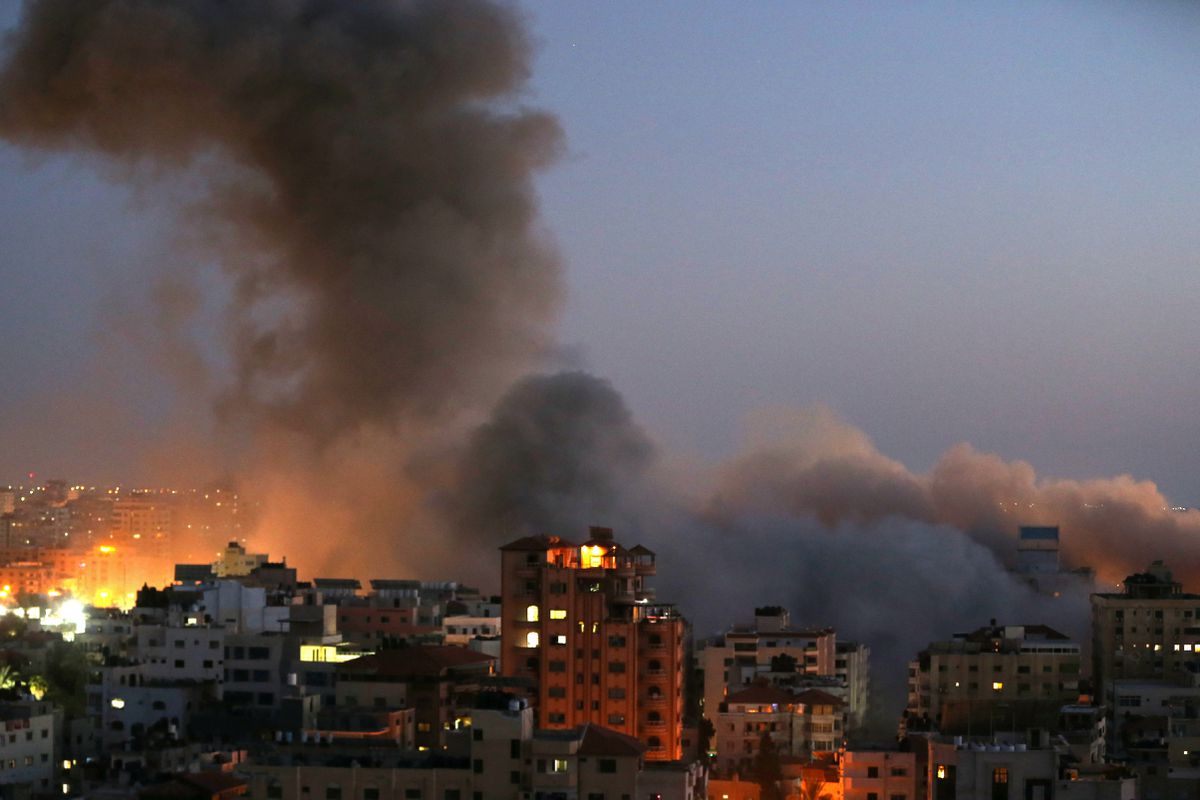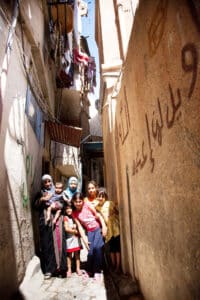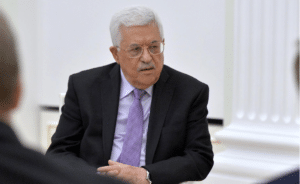Smoke rises from a building in Gaza after it was destroyed by Israeli air strikes (REUTERS/Ibraheem Abu Mustafa)
Today, Wednesday May 12th, the bombardment of the Gaza Strip further intensified as Israeli fighter jets bombed sites belonging to Palestinian armed groups, as well as police buildings and apartment blocks. Since the offensive began on Monday, Gaza’s health ministry says at least 53 people have been killed, including 14 children. More than 300 others have been wounded.
The events constitute the most severe escalation of violence since the 2014 Israeli war on Gaza. Here is a reconstruction of how the tensions have reached a boiling point.
Sheikh Jarrah expulsions
For weeks, Palestinian residents of the Sheikh Jarrah neighborhood in East Jerusalem have been protesting to prevent the expulsion of Palestinian families by Israeli settlers. Sheikh Jarrah is described by some as resembling a war zone, as Israeli settlers terrorize Palestinian residents under the protection of heavily armed Israeli police. The United Nations has warned the planned expulsions may amount to “war crimes”. Palestinian demonstrators protesting against the expulsions have clashed with Israeli police and Israeli far-right-wing activists.
Palestinians describe the expulsions as an “ongoing Nakba”: Nakba is the Palestinian term for the 1948 Palestinian exodus, which saw more than 700,000 Palestinian Arabs expelled from their homes and made refugee after the 1948 Palestine war, when the state of Israel was established. Palestinian protesters underscore that the expulsions in Sheikh Jarrah are part of the broader expulsion and ethnic cleansing of Palestinians from their homeland which started in 1948.
The Israeli government’s goals for the Jerusalem municipality is to “maintain a solid Jewish majority in the city”. This intent to dominate underlies Israel’s crimes against humanity of apartheid and persecution, which Human Rights Watch has documented in their recent report “A Threshold Crossed”, which was published on April 27th.
On Sunday 9th of May, Israel’s high court decided to postpone a ruling on the forced expulsion of four Palestinian families from the neighborhood. The court’s decision on Sunday to delay the ruling was a momentary victory for the residents of Sheikh Jarrah and the tireless demonstrators.
A Palestinian youth is pinned down by Israeli police at a protest against the forcible eviction of Palestinian families (Image source: Al Jazeera)
#SaveSheikhJarrah and social media censorship
Social media users from the ground and around the world have uploaded and shared video content and images about the attacks by settlers, using the hashtag in both English and Arabic #SaveSheikhJarrah.
Yet many have complained that their accounts have been censored, limited, or shut down. Mohammed El-Kurd, a Palestinian writer from Jerusalem and a native of Sheikh Jarrah whose family has been living under the threat of displacement, was posting videos and stories on the violence when he received a warning that his account might be deleted.
Ramadan and Al-Aqsa Mosque
Tensions had already been rising as Israeli security forces had blocked access for Palestinians from outside Jerusalem who wished to visit the mosque for prayers during the last days of Ramadan, the sacred Muslim month of fasting.
On Friday 7th of May, tens of thousands of Muslim worshippers filled the Al-Aqsa Mosque compound – Islam’s third holiest site – to pray on the final Friday of Ramadan. Many worshippers stayed on afterwards to protest against the expulsions. Heavily deployed Israeli police fired rubber-coated bullets and stun grenades at protesters, who then responded by throwing stones. Some 205 Palestinians and 17 Israeli officers were wounded.
Monday: boiling point
After a violent weekend, Israeli security forces stormed the Al-Aqsa mosque on Monday morning, again firing rubber-coated bullets, tear gas and sound bombs at gathered worshippers. More than 330 Palestinians were wounded by the Israeli police according to emergency relief organisations, and 20 Israeli officers were also injured.
On top of this, Monday the 10th of May was also the celebration of Jerusalem Day, an annual event to celebrate Israel’s capture of East Jerusalem in 1967. The customary march on Jerusalem Day is seen by Palestinians as a provocation, since Palestinians claim East Jerusalem as the capital of their future state. Israeli sovereignty over Jerusalem is rejected by most of the world.
Minutes before the Jerusalem Day march was to begin on Monday afternoon, the government rerouted it on a less contentious path to prevent provocations, but those measures came too late to contain the spiraling violence.
Besides the tensions in Jerusalem, the internal Palestinian political rivalry has also been fueling the current conflict. In particular the decision by Palestinian president Mahmoud Abbas to postpone elections that had been scheduled for later this month, has angered Hamas. “Hamas is trying to tell Abbas in one way or another, ‘You are not the only person or party who calls the shots,’” said Mkhaimar Abusada, a political science professor at Al Azhar University in Gaza.
Tensions escalate into violence
Hamas had been threatening for weeks to respond with force to what it described as Israeli provocations in Jerusalem. On Monday, angered by the raid on the Al-Aqsa mosque, Hamas made good on that promise: Hamas militants fired some 150 rockets across Israel, the Israeli Army said. At least one landed in a village west of Jerusalem, causing damage to houses but no casualties.
This was the first time Hamas fired toward the city since 2014. Israel returned fire with airstrikes, as Israeli Prime Minister Benjamin Netanyahu in turn made good on his promise that “Israel will respond with great force.”
By early Tuesday morning, Hamas had retaliated and fired some 200 rockets towards Israel, according to the Israeli military, including several targeted at Jerusalem. At least two Israelis were killed.
Israeli aerial attacks, which hit apartment buildings as well as other targets, killed at least 26 Palestinians, including children, health authorities in Gaza said on Tuesday.
Some are speculating of a third Palestinian uprising, after uprisings in 1987 and 2000. European nations and the United States have called on both sides to remain calm and to de-escalate. However, it seems likely that escalation will continue to happen unless the current conflict’s root causes – the illegal suppression and expulsion of Palestinians – are put to an end.
Sources: NewYorkTimes, AlJazeera1, AlJazeera2, ArabNews, MiddleEastEye, AlJazeera3, HumanRightsWatch



